Computer Science Technology Report: Driverless Cars Analysis
VerifiedAdded on 2022/08/25
|14
|2952
|17
Report
AI Summary
This report provides a comprehensive overview of driverless car technology. It begins with an introduction to autonomous vehicles, defining them as cars that can operate without human intervention, and then explores their working principles, which involve sensors, algorithms, and machine learning. The report details various features of self-driving cars, such as adaptive cruise control, automatic braking, automatic parking, autopilot, lane-keep assist, and sign recognition. It discusses the potential impacts of driverless cars on safety, equity, and the environment. Furthermore, the report examines the competitive advantages that driverless car technology offers, including product differentiation, low prices, and barriers to entry. The report also includes an analysis of Porter's Five Forces and lists the advantages of driverless cars, such as benefits for disabled and elderly people and reduced commuting time. The report then provides an overview of current uses, including Google's investment in self-driving cars and existing features in vehicles like Mercedes-Benz's intelligent drive. Finally, the report explores the future uses of autonomous vehicles, highlighting the potential for integration with various aspects of life and the possibilities for taxi services, food delivery, and public transportation. The report concludes by emphasizing the importance of driverless cars as a significant technological innovation.
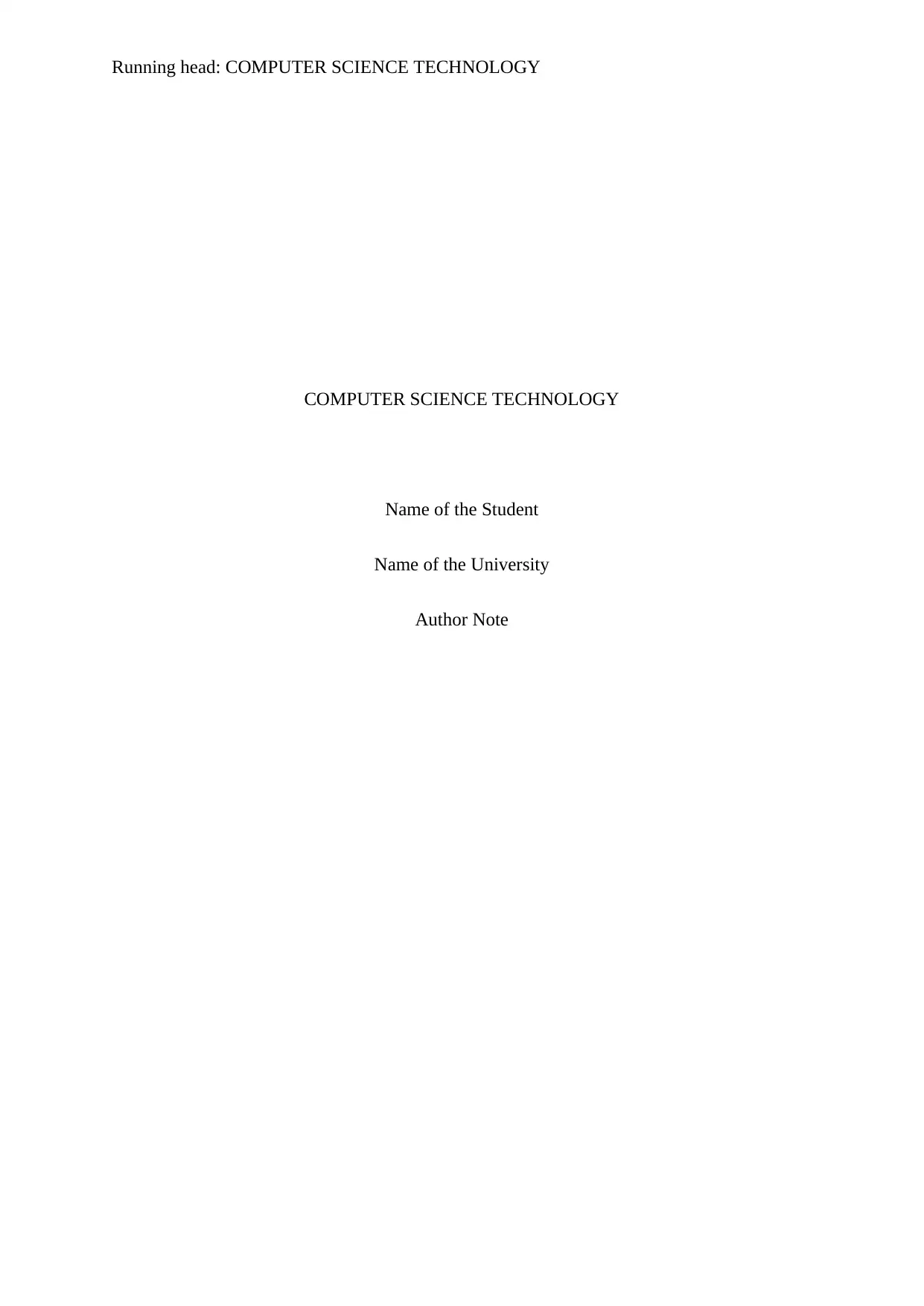
Running head: COMPUTER SCIENCE TECHNOLOGY
COMPUTER SCIENCE TECHNOLOGY
Name of the Student
Name of the University
Author Note
COMPUTER SCIENCE TECHNOLOGY
Name of the Student
Name of the University
Author Note
Paraphrase This Document
Need a fresh take? Get an instant paraphrase of this document with our AI Paraphraser
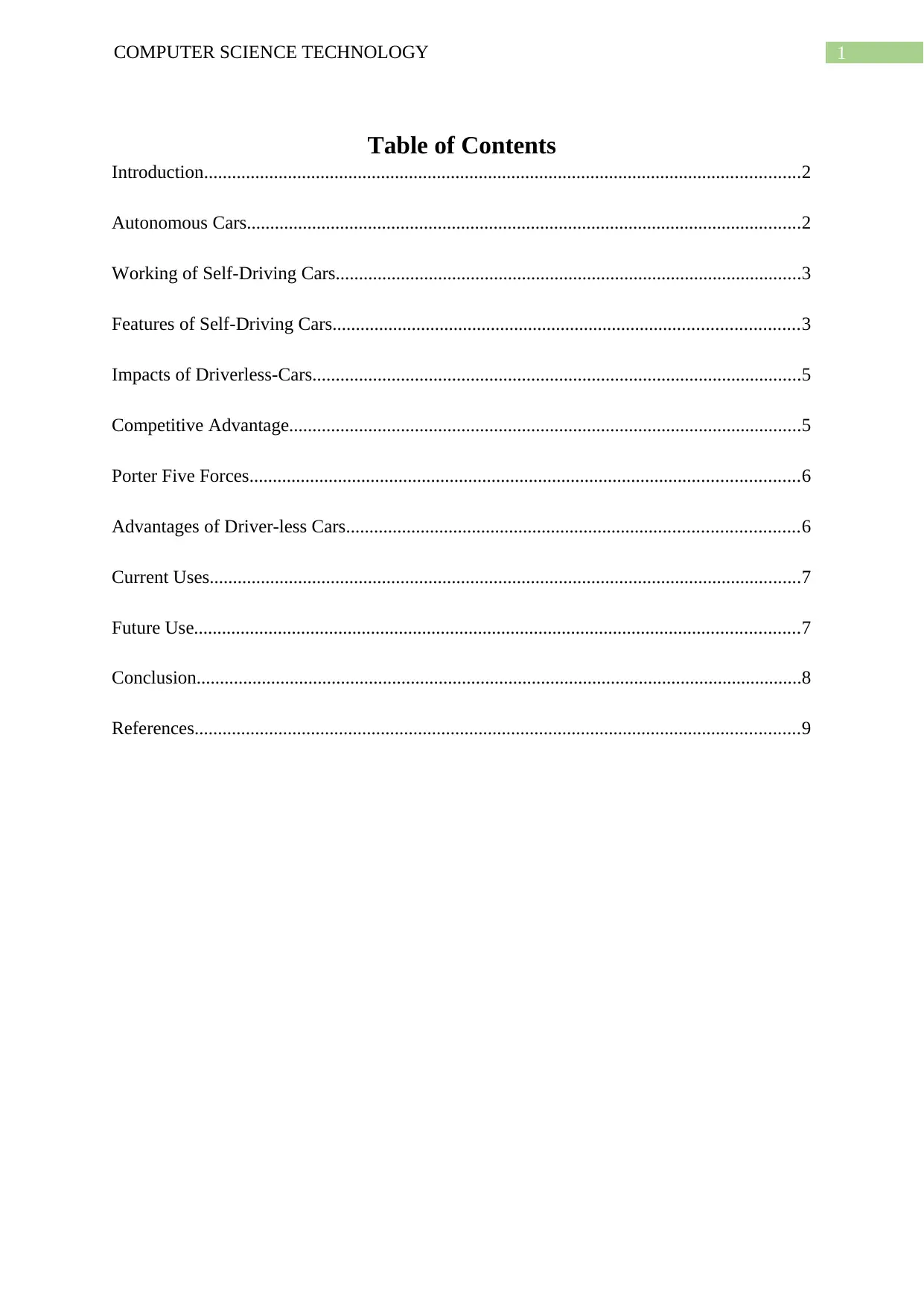
1COMPUTER SCIENCE TECHNOLOGY
Table of Contents
Introduction................................................................................................................................2
Autonomous Cars.......................................................................................................................2
Working of Self-Driving Cars....................................................................................................3
Features of Self-Driving Cars....................................................................................................3
Impacts of Driverless-Cars.........................................................................................................5
Competitive Advantage..............................................................................................................5
Porter Five Forces......................................................................................................................6
Advantages of Driver-less Cars.................................................................................................6
Current Uses...............................................................................................................................7
Future Use..................................................................................................................................7
Conclusion..................................................................................................................................8
References..................................................................................................................................9
Table of Contents
Introduction................................................................................................................................2
Autonomous Cars.......................................................................................................................2
Working of Self-Driving Cars....................................................................................................3
Features of Self-Driving Cars....................................................................................................3
Impacts of Driverless-Cars.........................................................................................................5
Competitive Advantage..............................................................................................................5
Porter Five Forces......................................................................................................................6
Advantages of Driver-less Cars.................................................................................................6
Current Uses...............................................................................................................................7
Future Use..................................................................................................................................7
Conclusion..................................................................................................................................8
References..................................................................................................................................9
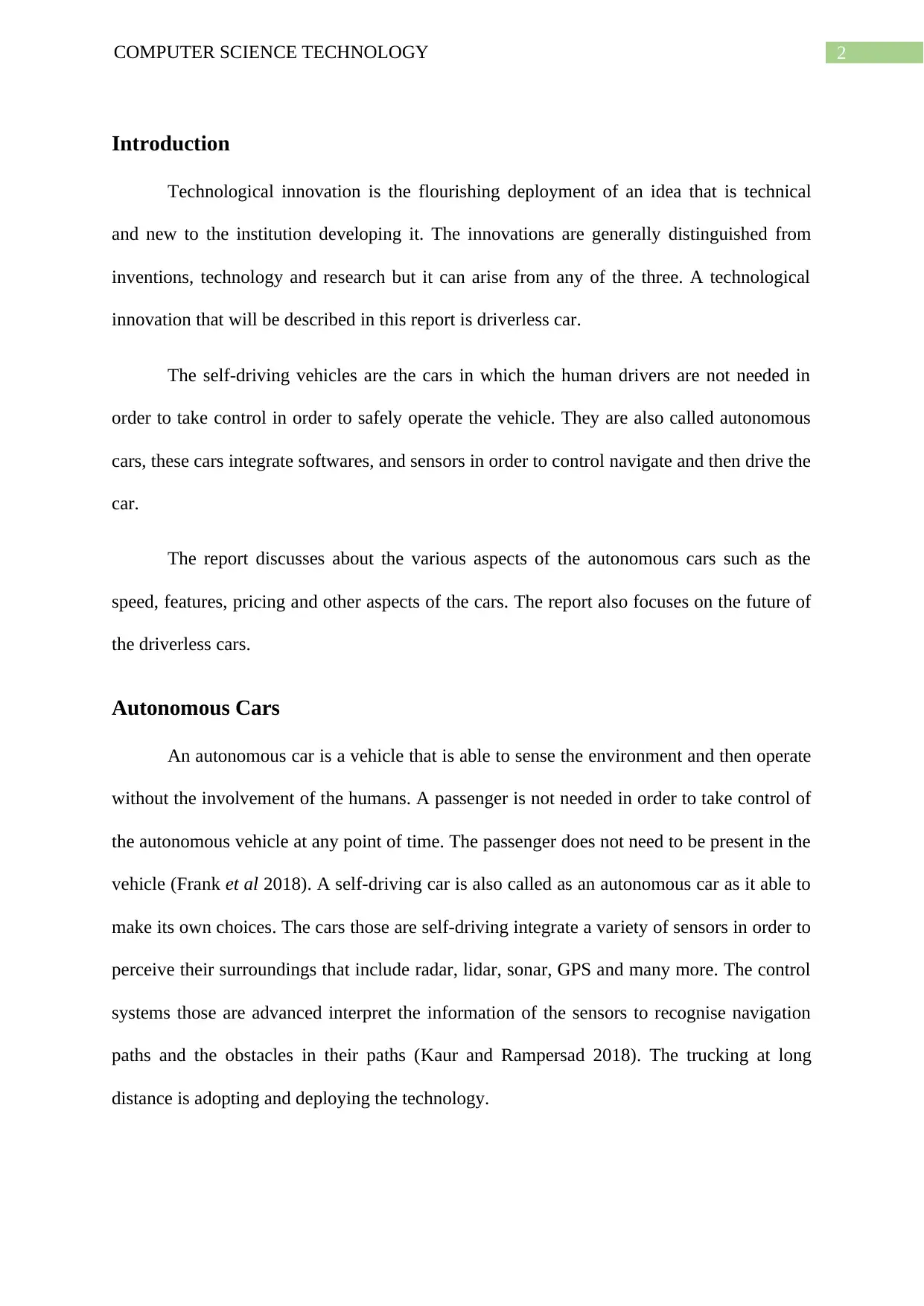
2COMPUTER SCIENCE TECHNOLOGY
Introduction
Technological innovation is the flourishing deployment of an idea that is technical
and new to the institution developing it. The innovations are generally distinguished from
inventions, technology and research but it can arise from any of the three. A technological
innovation that will be described in this report is driverless car.
The self-driving vehicles are the cars in which the human drivers are not needed in
order to take control in order to safely operate the vehicle. They are also called autonomous
cars, these cars integrate softwares, and sensors in order to control navigate and then drive the
car.
The report discusses about the various aspects of the autonomous cars such as the
speed, features, pricing and other aspects of the cars. The report also focuses on the future of
the driverless cars.
Autonomous Cars
An autonomous car is a vehicle that is able to sense the environment and then operate
without the involvement of the humans. A passenger is not needed in order to take control of
the autonomous vehicle at any point of time. The passenger does not need to be present in the
vehicle (Frank et al 2018). A self-driving car is also called as an autonomous car as it able to
make its own choices. The cars those are self-driving integrate a variety of sensors in order to
perceive their surroundings that include radar, lidar, sonar, GPS and many more. The control
systems those are advanced interpret the information of the sensors to recognise navigation
paths and the obstacles in their paths (Kaur and Rampersad 2018). The trucking at long
distance is adopting and deploying the technology.
Introduction
Technological innovation is the flourishing deployment of an idea that is technical
and new to the institution developing it. The innovations are generally distinguished from
inventions, technology and research but it can arise from any of the three. A technological
innovation that will be described in this report is driverless car.
The self-driving vehicles are the cars in which the human drivers are not needed in
order to take control in order to safely operate the vehicle. They are also called autonomous
cars, these cars integrate softwares, and sensors in order to control navigate and then drive the
car.
The report discusses about the various aspects of the autonomous cars such as the
speed, features, pricing and other aspects of the cars. The report also focuses on the future of
the driverless cars.
Autonomous Cars
An autonomous car is a vehicle that is able to sense the environment and then operate
without the involvement of the humans. A passenger is not needed in order to take control of
the autonomous vehicle at any point of time. The passenger does not need to be present in the
vehicle (Frank et al 2018). A self-driving car is also called as an autonomous car as it able to
make its own choices. The cars those are self-driving integrate a variety of sensors in order to
perceive their surroundings that include radar, lidar, sonar, GPS and many more. The control
systems those are advanced interpret the information of the sensors to recognise navigation
paths and the obstacles in their paths (Kaur and Rampersad 2018). The trucking at long
distance is adopting and deploying the technology.
⊘ This is a preview!⊘
Do you want full access?
Subscribe today to unlock all pages.

Trusted by 1+ million students worldwide
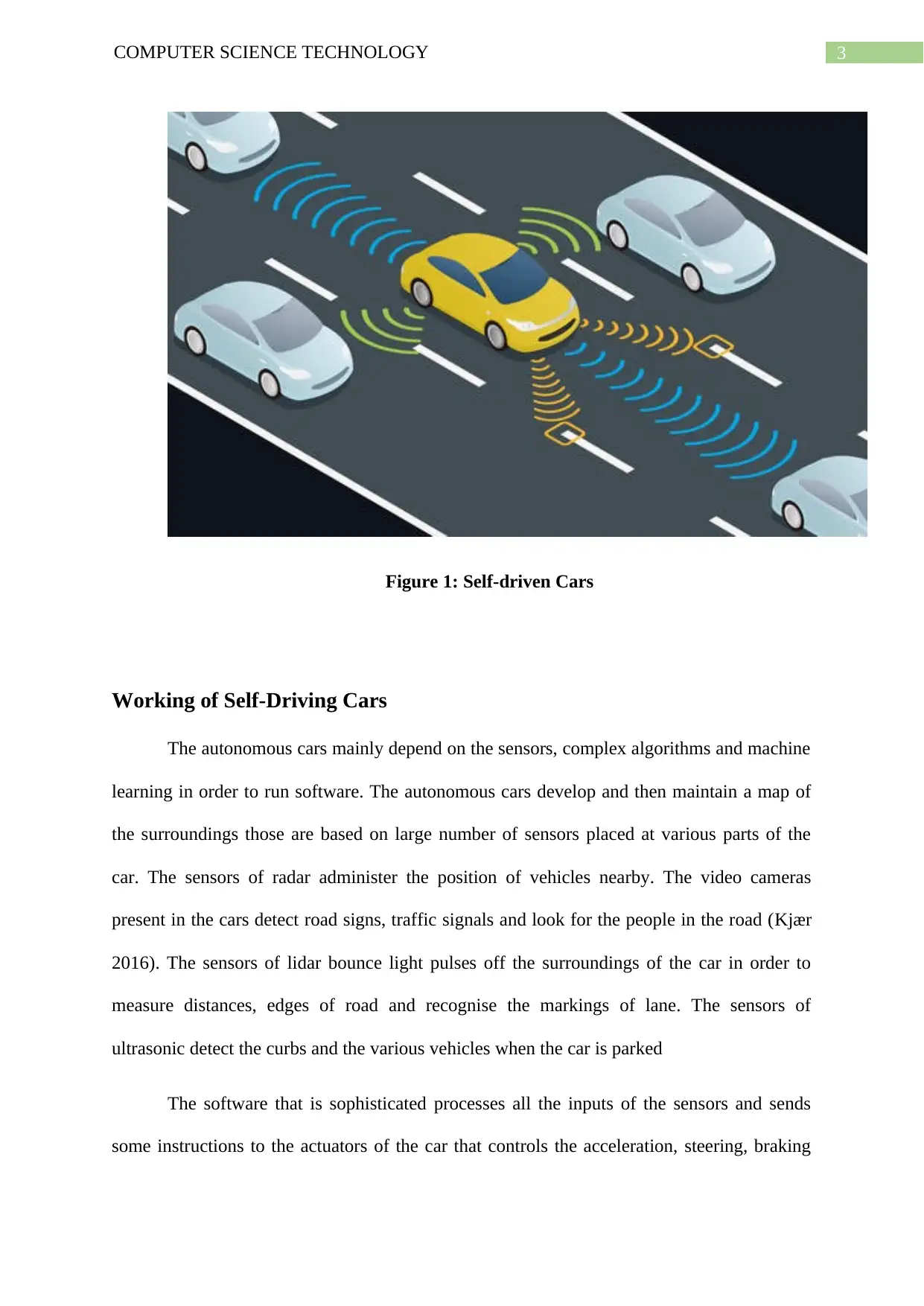
3COMPUTER SCIENCE TECHNOLOGY
Figure 1: Self-driven Cars
Working of Self-Driving Cars
The autonomous cars mainly depend on the sensors, complex algorithms and machine
learning in order to run software. The autonomous cars develop and then maintain a map of
the surroundings those are based on large number of sensors placed at various parts of the
car. The sensors of radar administer the position of vehicles nearby. The video cameras
present in the cars detect road signs, traffic signals and look for the people in the road (Kjær
2016). The sensors of lidar bounce light pulses off the surroundings of the car in order to
measure distances, edges of road and recognise the markings of lane. The sensors of
ultrasonic detect the curbs and the various vehicles when the car is parked
The software that is sophisticated processes all the inputs of the sensors and sends
some instructions to the actuators of the car that controls the acceleration, steering, braking
Figure 1: Self-driven Cars
Working of Self-Driving Cars
The autonomous cars mainly depend on the sensors, complex algorithms and machine
learning in order to run software. The autonomous cars develop and then maintain a map of
the surroundings those are based on large number of sensors placed at various parts of the
car. The sensors of radar administer the position of vehicles nearby. The video cameras
present in the cars detect road signs, traffic signals and look for the people in the road (Kjær
2016). The sensors of lidar bounce light pulses off the surroundings of the car in order to
measure distances, edges of road and recognise the markings of lane. The sensors of
ultrasonic detect the curbs and the various vehicles when the car is parked
The software that is sophisticated processes all the inputs of the sensors and sends
some instructions to the actuators of the car that controls the acceleration, steering, braking
Paraphrase This Document
Need a fresh take? Get an instant paraphrase of this document with our AI Paraphraser
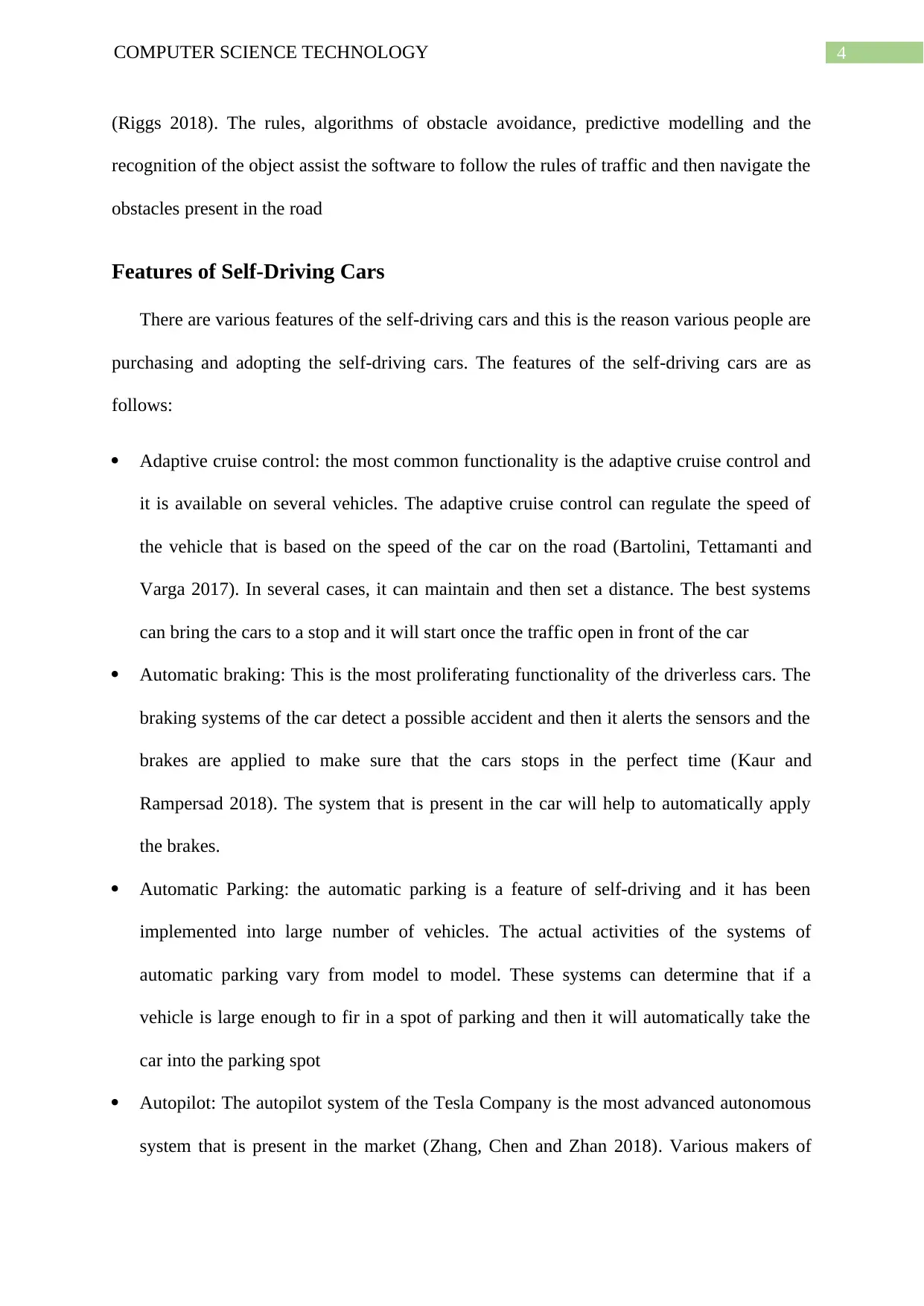
4COMPUTER SCIENCE TECHNOLOGY
(Riggs 2018). The rules, algorithms of obstacle avoidance, predictive modelling and the
recognition of the object assist the software to follow the rules of traffic and then navigate the
obstacles present in the road
Features of Self-Driving Cars
There are various features of the self-driving cars and this is the reason various people are
purchasing and adopting the self-driving cars. The features of the self-driving cars are as
follows:
Adaptive cruise control: the most common functionality is the adaptive cruise control and
it is available on several vehicles. The adaptive cruise control can regulate the speed of
the vehicle that is based on the speed of the car on the road (Bartolini, Tettamanti and
Varga 2017). In several cases, it can maintain and then set a distance. The best systems
can bring the cars to a stop and it will start once the traffic open in front of the car
Automatic braking: This is the most proliferating functionality of the driverless cars. The
braking systems of the car detect a possible accident and then it alerts the sensors and the
brakes are applied to make sure that the cars stops in the perfect time (Kaur and
Rampersad 2018). The system that is present in the car will help to automatically apply
the brakes.
Automatic Parking: the automatic parking is a feature of self-driving and it has been
implemented into large number of vehicles. The actual activities of the systems of
automatic parking vary from model to model. These systems can determine that if a
vehicle is large enough to fir in a spot of parking and then it will automatically take the
car into the parking spot
Autopilot: The autopilot system of the Tesla Company is the most advanced autonomous
system that is present in the market (Zhang, Chen and Zhan 2018). Various makers of
(Riggs 2018). The rules, algorithms of obstacle avoidance, predictive modelling and the
recognition of the object assist the software to follow the rules of traffic and then navigate the
obstacles present in the road
Features of Self-Driving Cars
There are various features of the self-driving cars and this is the reason various people are
purchasing and adopting the self-driving cars. The features of the self-driving cars are as
follows:
Adaptive cruise control: the most common functionality is the adaptive cruise control and
it is available on several vehicles. The adaptive cruise control can regulate the speed of
the vehicle that is based on the speed of the car on the road (Bartolini, Tettamanti and
Varga 2017). In several cases, it can maintain and then set a distance. The best systems
can bring the cars to a stop and it will start once the traffic open in front of the car
Automatic braking: This is the most proliferating functionality of the driverless cars. The
braking systems of the car detect a possible accident and then it alerts the sensors and the
brakes are applied to make sure that the cars stops in the perfect time (Kaur and
Rampersad 2018). The system that is present in the car will help to automatically apply
the brakes.
Automatic Parking: the automatic parking is a feature of self-driving and it has been
implemented into large number of vehicles. The actual activities of the systems of
automatic parking vary from model to model. These systems can determine that if a
vehicle is large enough to fir in a spot of parking and then it will automatically take the
car into the parking spot
Autopilot: The autopilot system of the Tesla Company is the most advanced autonomous
system that is present in the market (Zhang, Chen and Zhan 2018). Various makers of
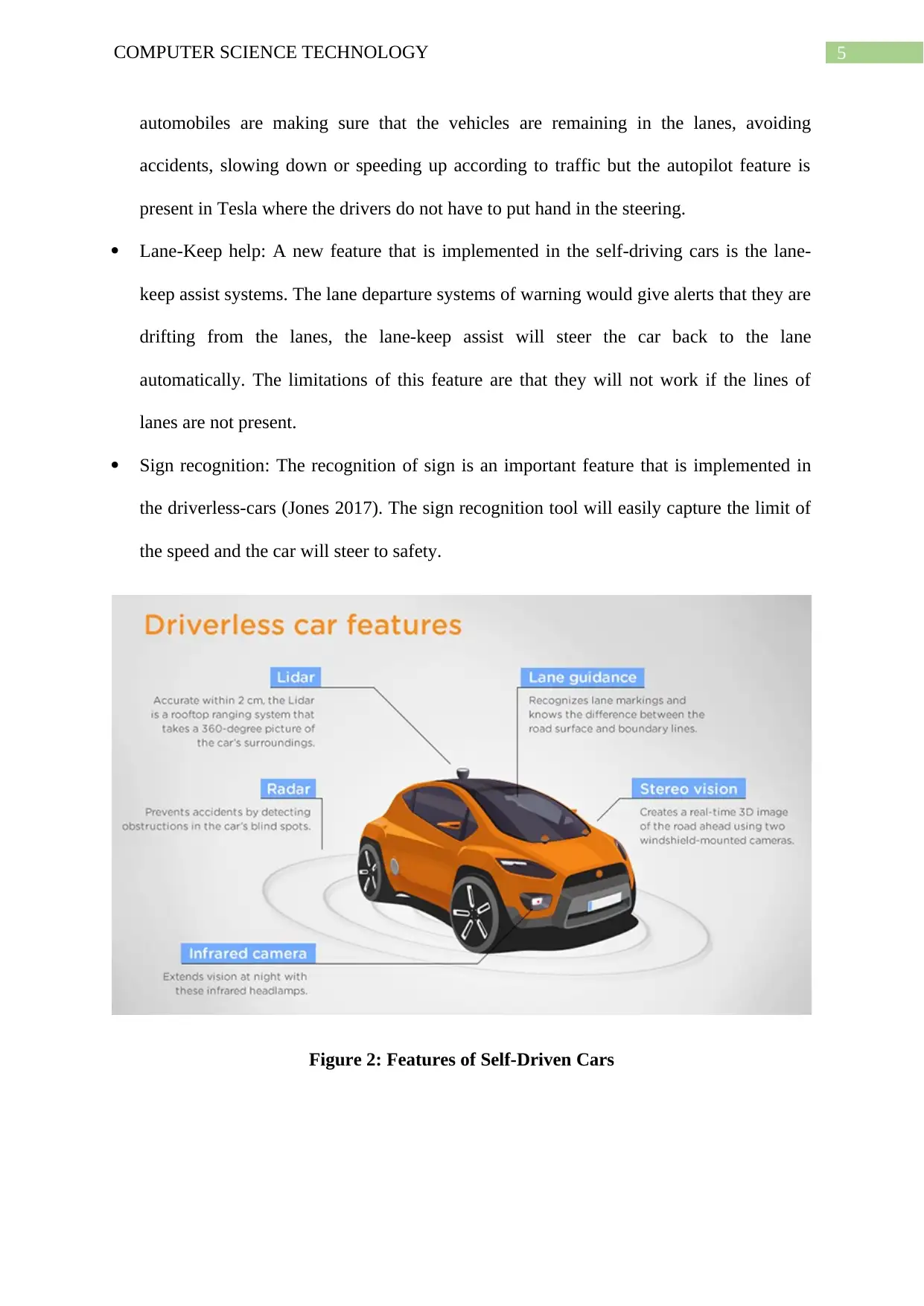
5COMPUTER SCIENCE TECHNOLOGY
automobiles are making sure that the vehicles are remaining in the lanes, avoiding
accidents, slowing down or speeding up according to traffic but the autopilot feature is
present in Tesla where the drivers do not have to put hand in the steering.
Lane-Keep help: A new feature that is implemented in the self-driving cars is the lane-
keep assist systems. The lane departure systems of warning would give alerts that they are
drifting from the lanes, the lane-keep assist will steer the car back to the lane
automatically. The limitations of this feature are that they will not work if the lines of
lanes are not present.
Sign recognition: The recognition of sign is an important feature that is implemented in
the driverless-cars (Jones 2017). The sign recognition tool will easily capture the limit of
the speed and the car will steer to safety.
Figure 2: Features of Self-Driven Cars
automobiles are making sure that the vehicles are remaining in the lanes, avoiding
accidents, slowing down or speeding up according to traffic but the autopilot feature is
present in Tesla where the drivers do not have to put hand in the steering.
Lane-Keep help: A new feature that is implemented in the self-driving cars is the lane-
keep assist systems. The lane departure systems of warning would give alerts that they are
drifting from the lanes, the lane-keep assist will steer the car back to the lane
automatically. The limitations of this feature are that they will not work if the lines of
lanes are not present.
Sign recognition: The recognition of sign is an important feature that is implemented in
the driverless-cars (Jones 2017). The sign recognition tool will easily capture the limit of
the speed and the car will steer to safety.
Figure 2: Features of Self-Driven Cars
⊘ This is a preview!⊘
Do you want full access?
Subscribe today to unlock all pages.

Trusted by 1+ million students worldwide
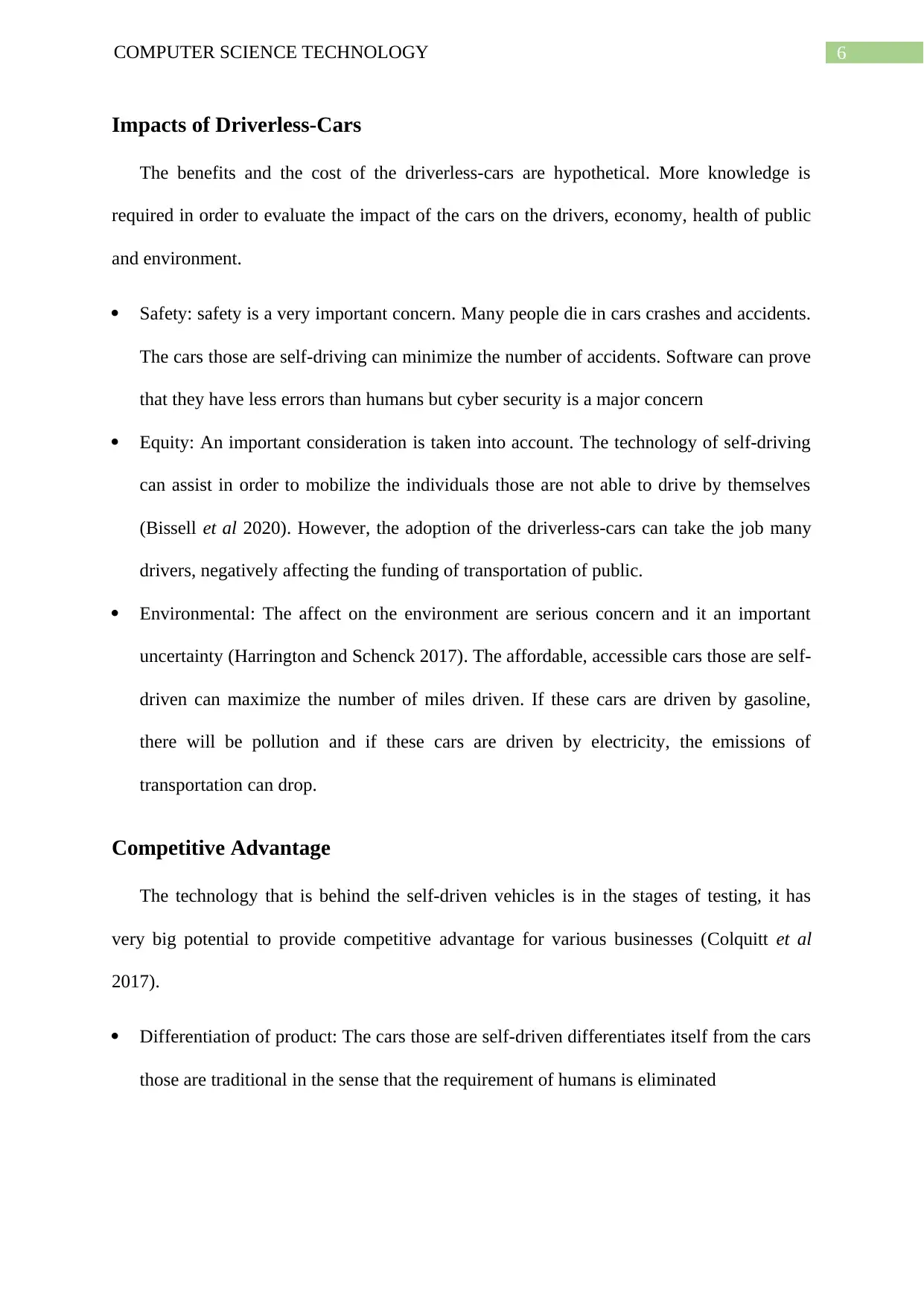
6COMPUTER SCIENCE TECHNOLOGY
Impacts of Driverless-Cars
The benefits and the cost of the driverless-cars are hypothetical. More knowledge is
required in order to evaluate the impact of the cars on the drivers, economy, health of public
and environment.
Safety: safety is a very important concern. Many people die in cars crashes and accidents.
The cars those are self-driving can minimize the number of accidents. Software can prove
that they have less errors than humans but cyber security is a major concern
Equity: An important consideration is taken into account. The technology of self-driving
can assist in order to mobilize the individuals those are not able to drive by themselves
(Bissell et al 2020). However, the adoption of the driverless-cars can take the job many
drivers, negatively affecting the funding of transportation of public.
Environmental: The affect on the environment are serious concern and it an important
uncertainty (Harrington and Schenck 2017). The affordable, accessible cars those are self-
driven can maximize the number of miles driven. If these cars are driven by gasoline,
there will be pollution and if these cars are driven by electricity, the emissions of
transportation can drop.
Competitive Advantage
The technology that is behind the self-driven vehicles is in the stages of testing, it has
very big potential to provide competitive advantage for various businesses (Colquitt et al
2017).
Differentiation of product: The cars those are self-driven differentiates itself from the cars
those are traditional in the sense that the requirement of humans is eliminated
Impacts of Driverless-Cars
The benefits and the cost of the driverless-cars are hypothetical. More knowledge is
required in order to evaluate the impact of the cars on the drivers, economy, health of public
and environment.
Safety: safety is a very important concern. Many people die in cars crashes and accidents.
The cars those are self-driving can minimize the number of accidents. Software can prove
that they have less errors than humans but cyber security is a major concern
Equity: An important consideration is taken into account. The technology of self-driving
can assist in order to mobilize the individuals those are not able to drive by themselves
(Bissell et al 2020). However, the adoption of the driverless-cars can take the job many
drivers, negatively affecting the funding of transportation of public.
Environmental: The affect on the environment are serious concern and it an important
uncertainty (Harrington and Schenck 2017). The affordable, accessible cars those are self-
driven can maximize the number of miles driven. If these cars are driven by gasoline,
there will be pollution and if these cars are driven by electricity, the emissions of
transportation can drop.
Competitive Advantage
The technology that is behind the self-driven vehicles is in the stages of testing, it has
very big potential to provide competitive advantage for various businesses (Colquitt et al
2017).
Differentiation of product: The cars those are self-driven differentiates itself from the cars
those are traditional in the sense that the requirement of humans is eliminated
Paraphrase This Document
Need a fresh take? Get an instant paraphrase of this document with our AI Paraphraser
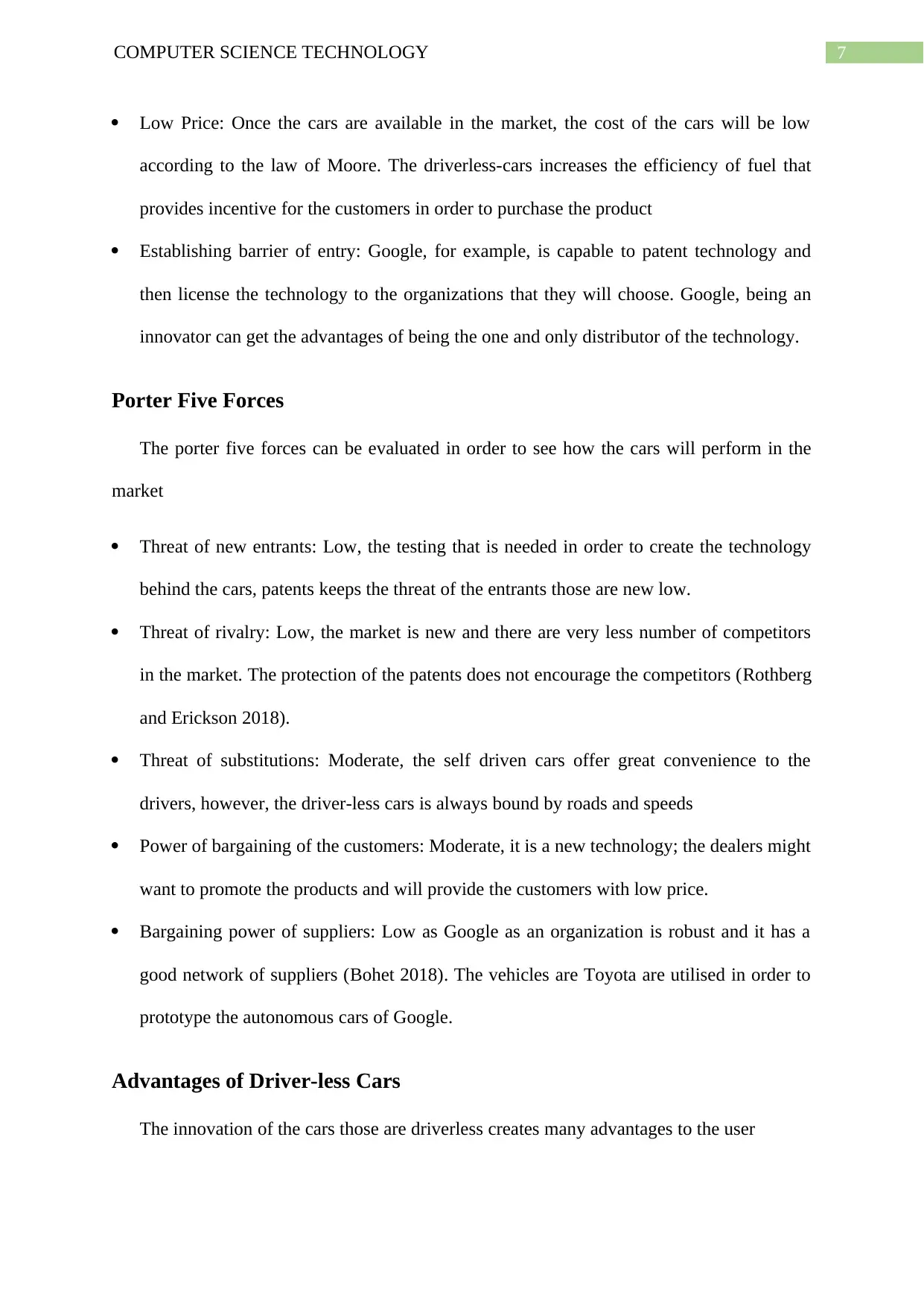
7COMPUTER SCIENCE TECHNOLOGY
Low Price: Once the cars are available in the market, the cost of the cars will be low
according to the law of Moore. The driverless-cars increases the efficiency of fuel that
provides incentive for the customers in order to purchase the product
Establishing barrier of entry: Google, for example, is capable to patent technology and
then license the technology to the organizations that they will choose. Google, being an
innovator can get the advantages of being the one and only distributor of the technology.
Porter Five Forces
The porter five forces can be evaluated in order to see how the cars will perform in the
market
Threat of new entrants: Low, the testing that is needed in order to create the technology
behind the cars, patents keeps the threat of the entrants those are new low.
Threat of rivalry: Low, the market is new and there are very less number of competitors
in the market. The protection of the patents does not encourage the competitors (Rothberg
and Erickson 2018).
Threat of substitutions: Moderate, the self driven cars offer great convenience to the
drivers, however, the driver-less cars is always bound by roads and speeds
Power of bargaining of the customers: Moderate, it is a new technology; the dealers might
want to promote the products and will provide the customers with low price.
Bargaining power of suppliers: Low as Google as an organization is robust and it has a
good network of suppliers (Bohet 2018). The vehicles are Toyota are utilised in order to
prototype the autonomous cars of Google.
Advantages of Driver-less Cars
The innovation of the cars those are driverless creates many advantages to the user
Low Price: Once the cars are available in the market, the cost of the cars will be low
according to the law of Moore. The driverless-cars increases the efficiency of fuel that
provides incentive for the customers in order to purchase the product
Establishing barrier of entry: Google, for example, is capable to patent technology and
then license the technology to the organizations that they will choose. Google, being an
innovator can get the advantages of being the one and only distributor of the technology.
Porter Five Forces
The porter five forces can be evaluated in order to see how the cars will perform in the
market
Threat of new entrants: Low, the testing that is needed in order to create the technology
behind the cars, patents keeps the threat of the entrants those are new low.
Threat of rivalry: Low, the market is new and there are very less number of competitors
in the market. The protection of the patents does not encourage the competitors (Rothberg
and Erickson 2018).
Threat of substitutions: Moderate, the self driven cars offer great convenience to the
drivers, however, the driver-less cars is always bound by roads and speeds
Power of bargaining of the customers: Moderate, it is a new technology; the dealers might
want to promote the products and will provide the customers with low price.
Bargaining power of suppliers: Low as Google as an organization is robust and it has a
good network of suppliers (Bohet 2018). The vehicles are Toyota are utilised in order to
prototype the autonomous cars of Google.
Advantages of Driver-less Cars
The innovation of the cars those are driverless creates many advantages to the user
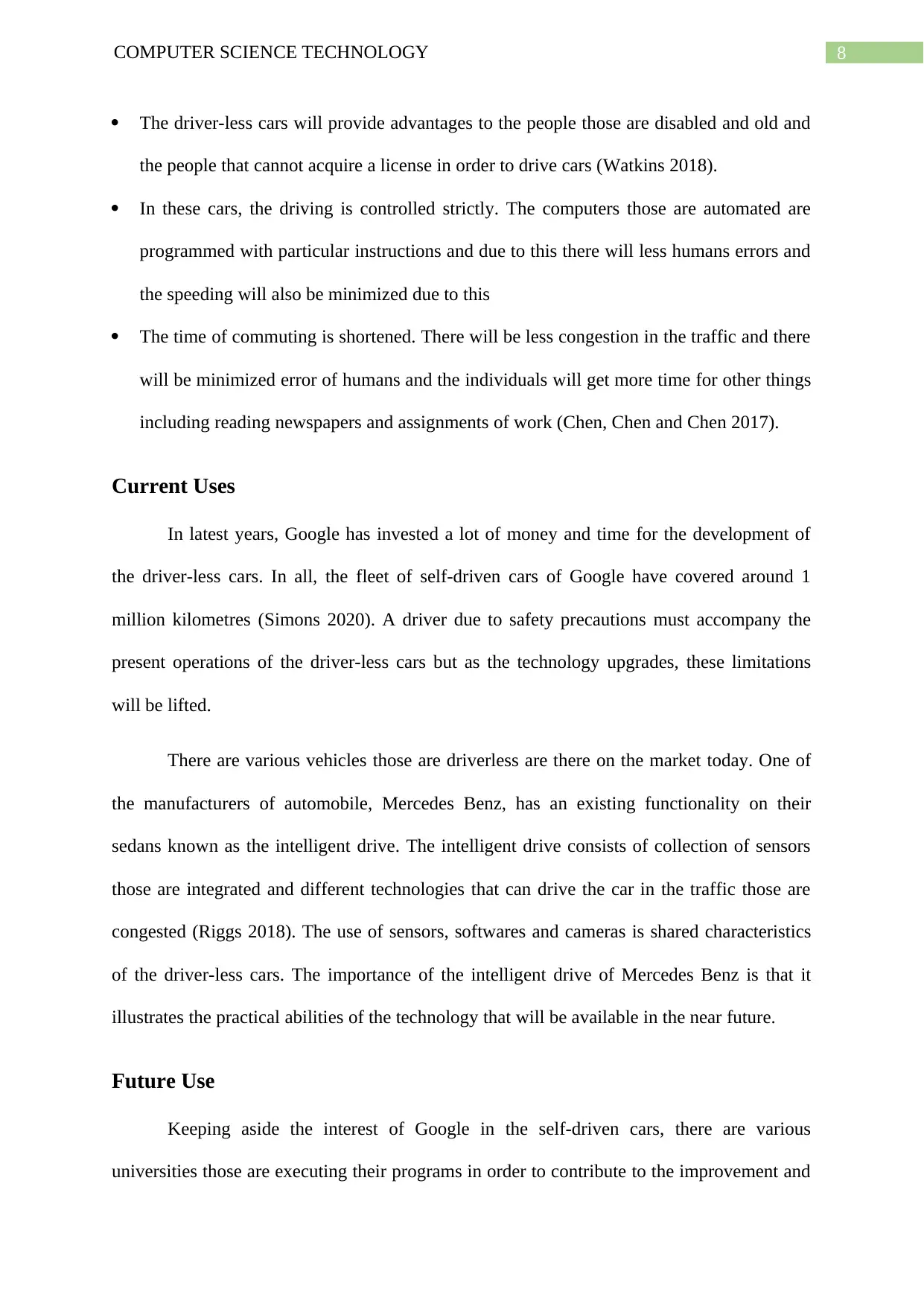
8COMPUTER SCIENCE TECHNOLOGY
The driver-less cars will provide advantages to the people those are disabled and old and
the people that cannot acquire a license in order to drive cars (Watkins 2018).
In these cars, the driving is controlled strictly. The computers those are automated are
programmed with particular instructions and due to this there will less humans errors and
the speeding will also be minimized due to this
The time of commuting is shortened. There will be less congestion in the traffic and there
will be minimized error of humans and the individuals will get more time for other things
including reading newspapers and assignments of work (Chen, Chen and Chen 2017).
Current Uses
In latest years, Google has invested a lot of money and time for the development of
the driver-less cars. In all, the fleet of self-driven cars of Google have covered around 1
million kilometres (Simons 2020). A driver due to safety precautions must accompany the
present operations of the driver-less cars but as the technology upgrades, these limitations
will be lifted.
There are various vehicles those are driverless are there on the market today. One of
the manufacturers of automobile, Mercedes Benz, has an existing functionality on their
sedans known as the intelligent drive. The intelligent drive consists of collection of sensors
those are integrated and different technologies that can drive the car in the traffic those are
congested (Riggs 2018). The use of sensors, softwares and cameras is shared characteristics
of the driver-less cars. The importance of the intelligent drive of Mercedes Benz is that it
illustrates the practical abilities of the technology that will be available in the near future.
Future Use
Keeping aside the interest of Google in the self-driven cars, there are various
universities those are executing their programs in order to contribute to the improvement and
The driver-less cars will provide advantages to the people those are disabled and old and
the people that cannot acquire a license in order to drive cars (Watkins 2018).
In these cars, the driving is controlled strictly. The computers those are automated are
programmed with particular instructions and due to this there will less humans errors and
the speeding will also be minimized due to this
The time of commuting is shortened. There will be less congestion in the traffic and there
will be minimized error of humans and the individuals will get more time for other things
including reading newspapers and assignments of work (Chen, Chen and Chen 2017).
Current Uses
In latest years, Google has invested a lot of money and time for the development of
the driver-less cars. In all, the fleet of self-driven cars of Google have covered around 1
million kilometres (Simons 2020). A driver due to safety precautions must accompany the
present operations of the driver-less cars but as the technology upgrades, these limitations
will be lifted.
There are various vehicles those are driverless are there on the market today. One of
the manufacturers of automobile, Mercedes Benz, has an existing functionality on their
sedans known as the intelligent drive. The intelligent drive consists of collection of sensors
those are integrated and different technologies that can drive the car in the traffic those are
congested (Riggs 2018). The use of sensors, softwares and cameras is shared characteristics
of the driver-less cars. The importance of the intelligent drive of Mercedes Benz is that it
illustrates the practical abilities of the technology that will be available in the near future.
Future Use
Keeping aside the interest of Google in the self-driven cars, there are various
universities those are executing their programs in order to contribute to the improvement and
⊘ This is a preview!⊘
Do you want full access?
Subscribe today to unlock all pages.

Trusted by 1+ million students worldwide
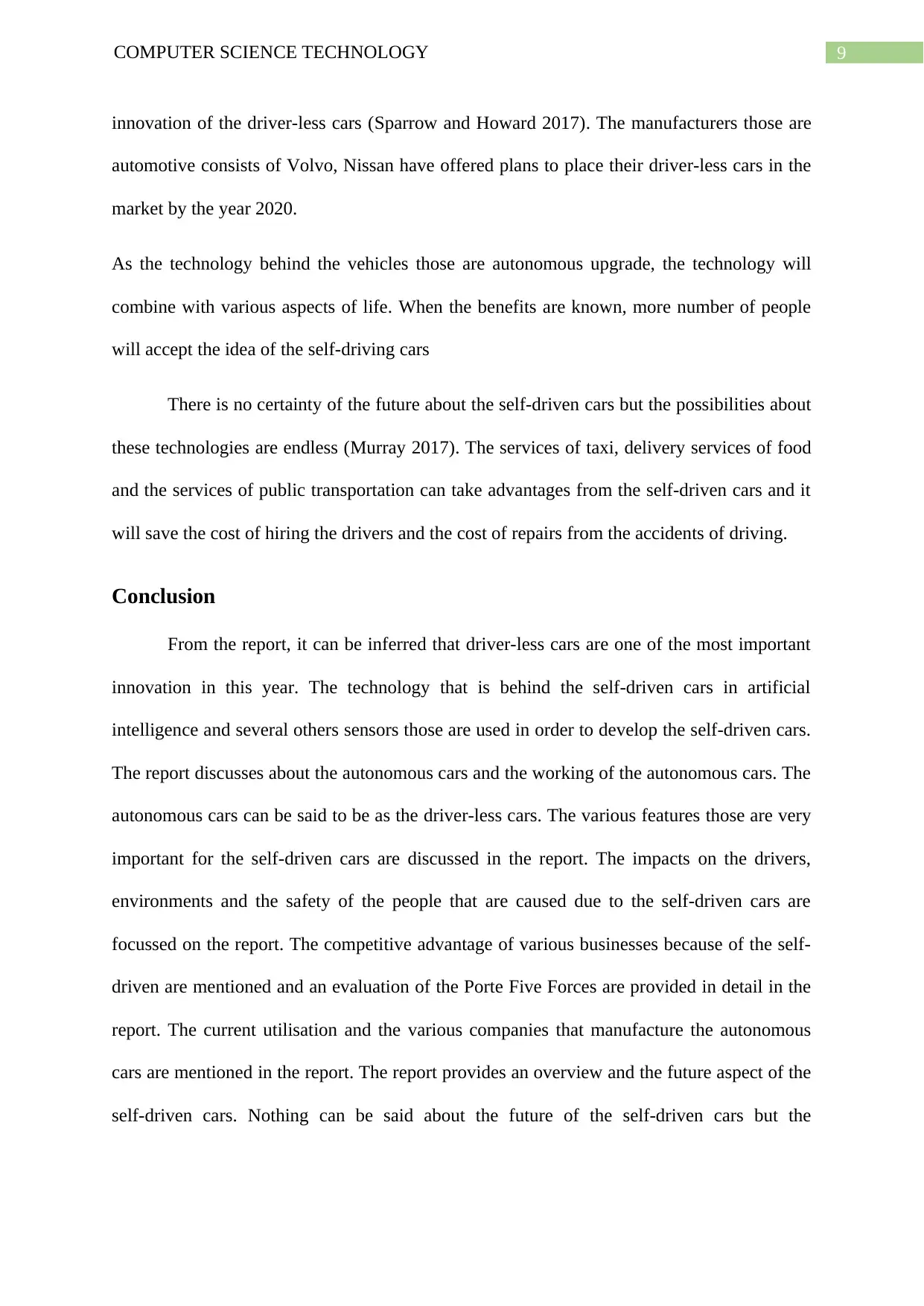
9COMPUTER SCIENCE TECHNOLOGY
innovation of the driver-less cars (Sparrow and Howard 2017). The manufacturers those are
automotive consists of Volvo, Nissan have offered plans to place their driver-less cars in the
market by the year 2020.
As the technology behind the vehicles those are autonomous upgrade, the technology will
combine with various aspects of life. When the benefits are known, more number of people
will accept the idea of the self-driving cars
There is no certainty of the future about the self-driven cars but the possibilities about
these technologies are endless (Murray 2017). The services of taxi, delivery services of food
and the services of public transportation can take advantages from the self-driven cars and it
will save the cost of hiring the drivers and the cost of repairs from the accidents of driving.
Conclusion
From the report, it can be inferred that driver-less cars are one of the most important
innovation in this year. The technology that is behind the self-driven cars in artificial
intelligence and several others sensors those are used in order to develop the self-driven cars.
The report discusses about the autonomous cars and the working of the autonomous cars. The
autonomous cars can be said to be as the driver-less cars. The various features those are very
important for the self-driven cars are discussed in the report. The impacts on the drivers,
environments and the safety of the people that are caused due to the self-driven cars are
focussed on the report. The competitive advantage of various businesses because of the self-
driven are mentioned and an evaluation of the Porte Five Forces are provided in detail in the
report. The current utilisation and the various companies that manufacture the autonomous
cars are mentioned in the report. The report provides an overview and the future aspect of the
self-driven cars. Nothing can be said about the future of the self-driven cars but the
innovation of the driver-less cars (Sparrow and Howard 2017). The manufacturers those are
automotive consists of Volvo, Nissan have offered plans to place their driver-less cars in the
market by the year 2020.
As the technology behind the vehicles those are autonomous upgrade, the technology will
combine with various aspects of life. When the benefits are known, more number of people
will accept the idea of the self-driving cars
There is no certainty of the future about the self-driven cars but the possibilities about
these technologies are endless (Murray 2017). The services of taxi, delivery services of food
and the services of public transportation can take advantages from the self-driven cars and it
will save the cost of hiring the drivers and the cost of repairs from the accidents of driving.
Conclusion
From the report, it can be inferred that driver-less cars are one of the most important
innovation in this year. The technology that is behind the self-driven cars in artificial
intelligence and several others sensors those are used in order to develop the self-driven cars.
The report discusses about the autonomous cars and the working of the autonomous cars. The
autonomous cars can be said to be as the driver-less cars. The various features those are very
important for the self-driven cars are discussed in the report. The impacts on the drivers,
environments and the safety of the people that are caused due to the self-driven cars are
focussed on the report. The competitive advantage of various businesses because of the self-
driven are mentioned and an evaluation of the Porte Five Forces are provided in detail in the
report. The current utilisation and the various companies that manufacture the autonomous
cars are mentioned in the report. The report provides an overview and the future aspect of the
self-driven cars. Nothing can be said about the future of the self-driven cars but the
Paraphrase This Document
Need a fresh take? Get an instant paraphrase of this document with our AI Paraphraser

10COMPUTER SCIENCE TECHNOLOGY
possibilities are endless of the self-driven cars and it is one of the important innovations of
computing in this era.
possibilities are endless of the self-driven cars and it is one of the important innovations of
computing in this era.
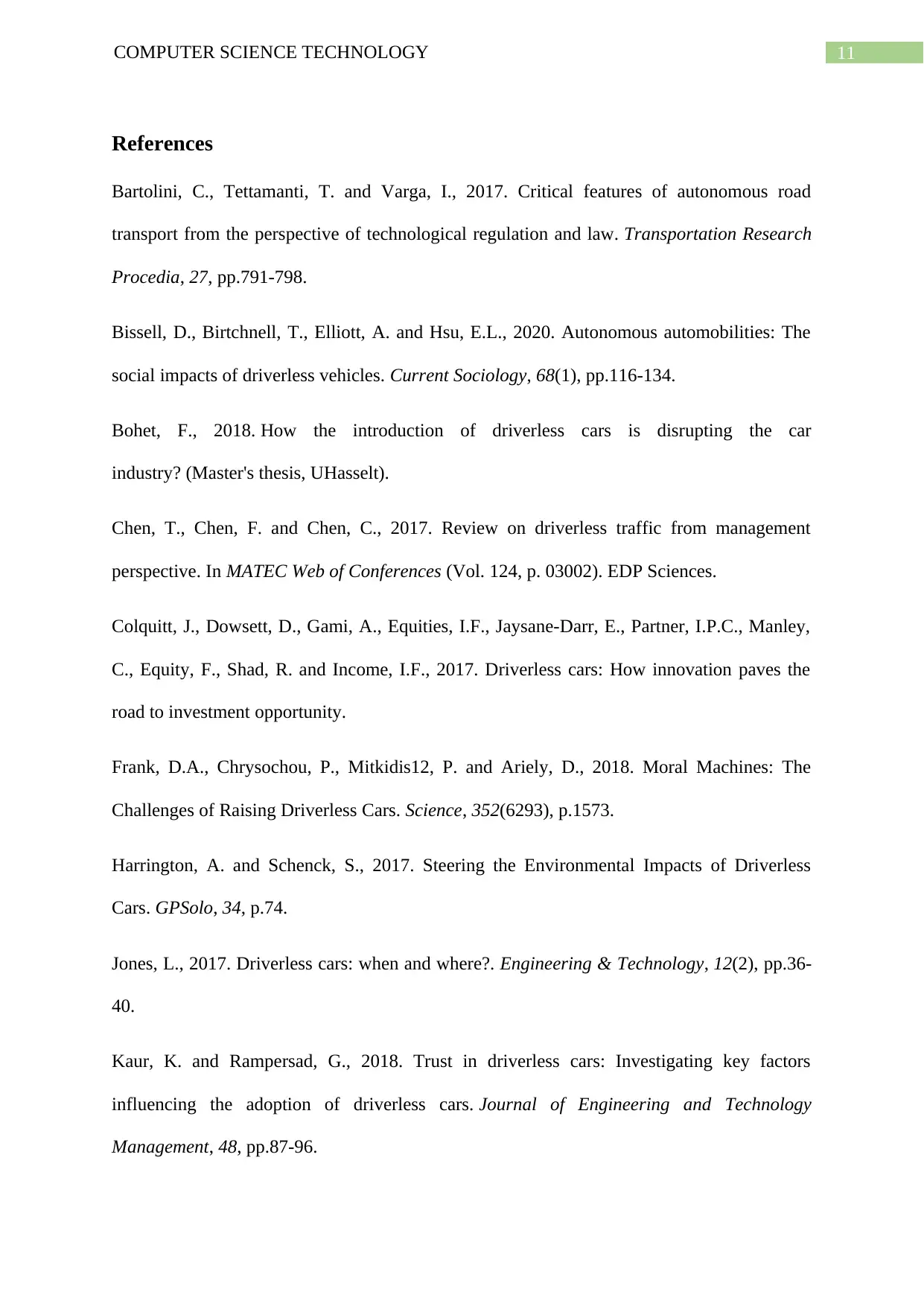
11COMPUTER SCIENCE TECHNOLOGY
References
Bartolini, C., Tettamanti, T. and Varga, I., 2017. Critical features of autonomous road
transport from the perspective of technological regulation and law. Transportation Research
Procedia, 27, pp.791-798.
Bissell, D., Birtchnell, T., Elliott, A. and Hsu, E.L., 2020. Autonomous automobilities: The
social impacts of driverless vehicles. Current Sociology, 68(1), pp.116-134.
Bohet, F., 2018. How the introduction of driverless cars is disrupting the car
industry? (Master's thesis, UHasselt).
Chen, T., Chen, F. and Chen, C., 2017. Review on driverless traffic from management
perspective. In MATEC Web of Conferences (Vol. 124, p. 03002). EDP Sciences.
Colquitt, J., Dowsett, D., Gami, A., Equities, I.F., Jaysane-Darr, E., Partner, I.P.C., Manley,
C., Equity, F., Shad, R. and Income, I.F., 2017. Driverless cars: How innovation paves the
road to investment opportunity.
Frank, D.A., Chrysochou, P., Mitkidis12, P. and Ariely, D., 2018. Moral Machines: The
Challenges of Raising Driverless Cars. Science, 352(6293), p.1573.
Harrington, A. and Schenck, S., 2017. Steering the Environmental Impacts of Driverless
Cars. GPSolo, 34, p.74.
Jones, L., 2017. Driverless cars: when and where?. Engineering & Technology, 12(2), pp.36-
40.
Kaur, K. and Rampersad, G., 2018. Trust in driverless cars: Investigating key factors
influencing the adoption of driverless cars. Journal of Engineering and Technology
Management, 48, pp.87-96.
References
Bartolini, C., Tettamanti, T. and Varga, I., 2017. Critical features of autonomous road
transport from the perspective of technological regulation and law. Transportation Research
Procedia, 27, pp.791-798.
Bissell, D., Birtchnell, T., Elliott, A. and Hsu, E.L., 2020. Autonomous automobilities: The
social impacts of driverless vehicles. Current Sociology, 68(1), pp.116-134.
Bohet, F., 2018. How the introduction of driverless cars is disrupting the car
industry? (Master's thesis, UHasselt).
Chen, T., Chen, F. and Chen, C., 2017. Review on driverless traffic from management
perspective. In MATEC Web of Conferences (Vol. 124, p. 03002). EDP Sciences.
Colquitt, J., Dowsett, D., Gami, A., Equities, I.F., Jaysane-Darr, E., Partner, I.P.C., Manley,
C., Equity, F., Shad, R. and Income, I.F., 2017. Driverless cars: How innovation paves the
road to investment opportunity.
Frank, D.A., Chrysochou, P., Mitkidis12, P. and Ariely, D., 2018. Moral Machines: The
Challenges of Raising Driverless Cars. Science, 352(6293), p.1573.
Harrington, A. and Schenck, S., 2017. Steering the Environmental Impacts of Driverless
Cars. GPSolo, 34, p.74.
Jones, L., 2017. Driverless cars: when and where?. Engineering & Technology, 12(2), pp.36-
40.
Kaur, K. and Rampersad, G., 2018. Trust in driverless cars: Investigating key factors
influencing the adoption of driverless cars. Journal of Engineering and Technology
Management, 48, pp.87-96.
⊘ This is a preview!⊘
Do you want full access?
Subscribe today to unlock all pages.

Trusted by 1+ million students worldwide
1 out of 14
Related Documents
Your All-in-One AI-Powered Toolkit for Academic Success.
+13062052269
info@desklib.com
Available 24*7 on WhatsApp / Email
![[object Object]](/_next/static/media/star-bottom.7253800d.svg)
Unlock your academic potential
Copyright © 2020–2025 A2Z Services. All Rights Reserved. Developed and managed by ZUCOL.





